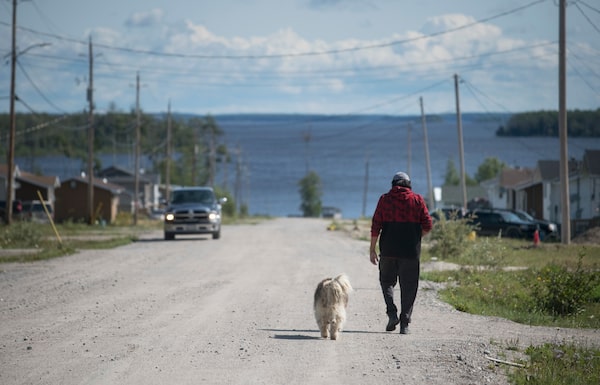
The remote community of the Neskantaga, Ontario First Nations, on Aug. 19, 2019.Fred Lum/The Globe and Mail
A group of Indigenous organizations has crafted what it is calling a first-of-its-kind Indigenous economic strategy, billing it as a blueprint for reducing poverty among Indigenous peoples and bolstering the Canadian economy.
Put together by a core group of five agencies, including the Canadian Council for Aboriginal Business, the strategy builds on the recommendations of the 2015 Truth and Reconciliation Commission. It revolves around four key areas: people, lands, infrastructure and finance.
The strategy includes 107 recommendations, described as “calls to economic prosperity,” including the creation of an Indigenous environmental oversight body and the establishment of supports for Indigenous ownership and investment in resource projects.
Currently, lenders consider First Nations’ equity participation in resource projects to be high-risk capital, according to Shannin Metatawabin, chief executive officer of the National Aboriginal Capital Corporations Association (NACCA), one of the organizations that put the strategy together.
“We need to change the page on Indigenous people being the highest-risk capital and see that their participation in resource projects actually de-risks the project,” Mr. Metatawabin said.
The strategy, which will be released on Monday, is based on the premise that closing socioeconomic gaps between Indigenous and non-Indigenous Canadians would reduce poverty among Indigenous peoples and pump billions into the Canadian economy. Economic marginalization – the squeezing out of Indigenous peoples from land and resources – costs an estimated $27.7-billion each year, according to a 2016 report from the National Indigenous Economic Development Board that is cited in the strategy.
Dawn Madahbee Leach, who is chairperson of the NIEDB, helped draft the new strategy. She is also president of Waubetek Business Development, an Aboriginal Financial Institution that operates in northern Ontario. She said she sometimes finds herself stymied when would-be borrowers come knocking at her door. (Aboriginal Financial Institutions, or AFIs, are federally backed lending institutions that serve Indigenous communities. NACCA is an umbrella organization for AFIs.)
Waubetek has a limit of $400,000 per loan. That’s not enough for, say, a construction company that wants to buy a new excavator or an entrepreneur who wants to open a franchise restaurant on reserve.
Historically, banks have been reluctant to lend to businesses on reserves, largely because of difficulty in arranging collateral – a result of the Indian Act’s restrictions on land ownership. This has left a gap in lending alternatives.
“We feel like our hands are tied,” Ms. Madahbee Leach said. “I’d love to do the loans because these are clients of ours who have already proven themselves, but we don’t have the level of financing.”
AFIs have provided $2.4-billion in loans to Indigenous businesses over the past 25 years, the strategy document says, using $365-million in government funding.
The strategy recommends strengthening funding for AFIs to meet loan demand.
It also calls for an infrastructure overhaul, saying the current system makes it so that infrastructure in Indigenous communities “costs the most to build, takes the longest to develop, and has the shortest operational life” compared to other government projects.
That infrastructure includes drinking water systems. A 2021 report by the Auditor General of Canada found the federal government’s efforts to address long-term drinking water advisories on reserves were hampered by an outdated policy and funding formula.
The federal government could help fix the Indigenous infrastructure problem by shifting from annual transfer payments to longer-term agreements that would allow First Nations to borrow against those funds, said Frank Busch, chief executive officer of NationFund, which provides financial advisory services to Indigenous communities.
The federal government has struck some 10-year funding agreements with First Nations as part of a new fiscal relationship now being developed, but those agreements still fall short when it comes to financing for 20- or 30-year timeframes, Mr. Busch said.
Access to capital is a consistent challenge for many First Nations, said Christopher Brown, managing Director of Helios Corp., which works with First Nations to develop projects in energy and other sectors.
Helios is currently working with Big Island Lake Cree Nation, based in Saskatchewan, to bring a high-speed fibre-optic network to the community, at an estimated cost of $10-million. The network would be majority-owned by the First Nation.
Major banks declined to finance the project, as did private equity groups, Mr. Brown said.
But Helios and the First Nation are currently in talks with the Canada Infrastructure Bank for funding, he added.
“They have come to the table for a $10-million project, which is well below their previous $100-million requirement,” he said.
The Canada Infrastructure Bank, a $35-billion Crown corporation created by the Trudeau government in 2017, has come under criticism for moving too slowly to deliver on its mandate to invest in large projects and encourage institutional investors to do the same. The House of Commons transport committee recommended this month that it be abolished.
Last year, the CIB announced it would spend $1-billion on Indigenous infrastructure. To be eligible, a project is required to have a budget of between $5-million and $100-million, and there must be evidence that no other lender will provide financing on terms that make the project viable.
Mr. Metatawabin would like to see the CIB program expanded, possibly into a standalone bank or fund that would use federal funds to backstop Indigenous equity stakes in major resource projects.
Your time is valuable. Have the Top Business Headlines newsletter conveniently delivered to your inbox in the morning or evening. Sign up today.
 Wendy Stueck
Wendy Stueck